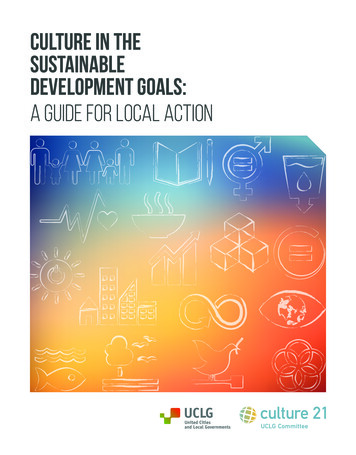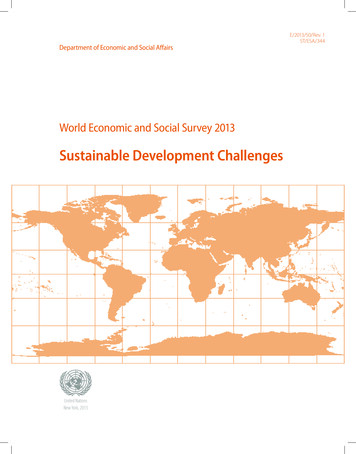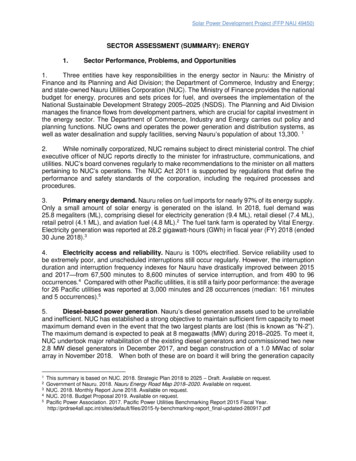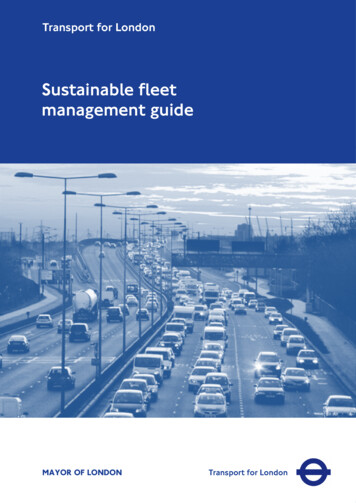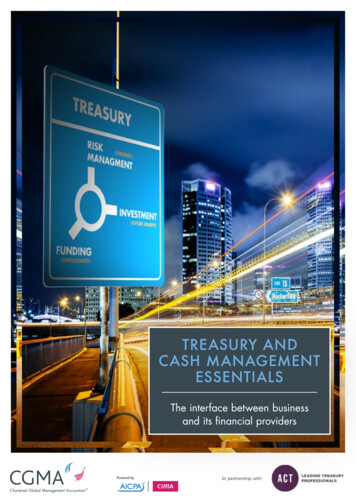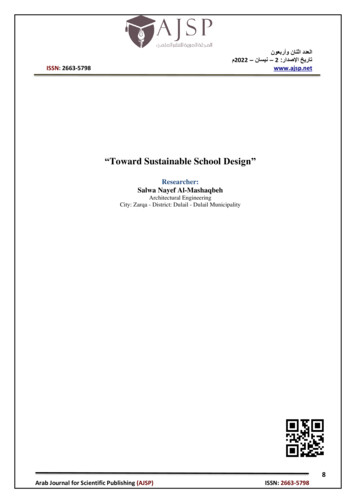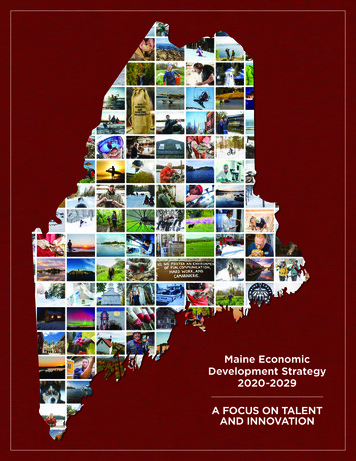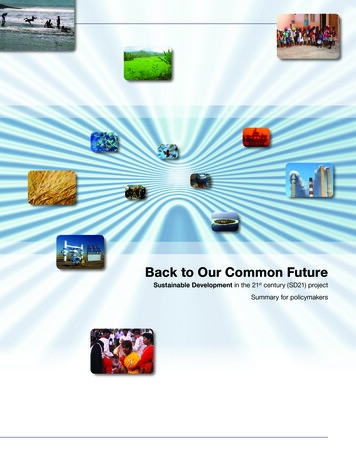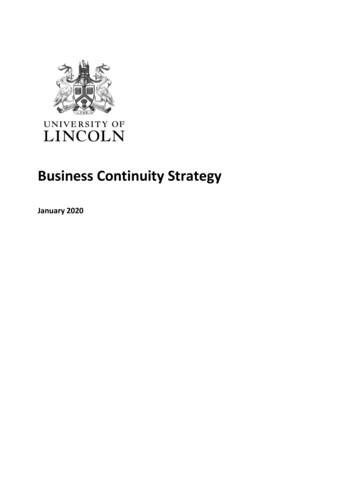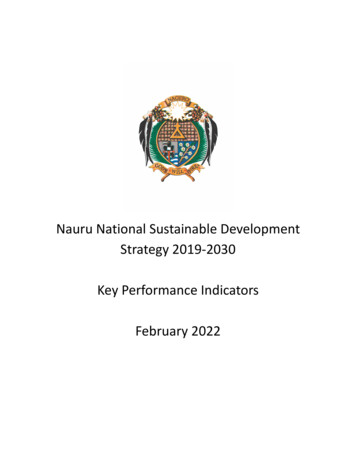
Transcription
Nauru National Sustainable DevelopmentStrategy 2019-2030Key Performance IndicatorsFebruary 2022
AcknowledgementsThis document was developed with the assistance of the following organisations: CENPACDepartment of the Chief SecretaryDepartment of Commerce, Industry and EnvironmentDepartment of Climate Change and National ResilienceDepartment of EducationDepartment of Finance - Customs, Treasury, NRO, Social Welfare, Statistics divisionsDepartment of FisheriesDepartment of HealthDepartment of InfrastructureDepartment of ICTDepartment of Internal AffairsDepartment of JudiciaryDepartment of JusticeDepartment of Lands and SurveyDepartment of People living with DisabilitiesDepartment of SportsDepartment of TransportDepartment of Women’s and Social Development AffairsEigiguLands CommitteeNauru Maritime Port AuthorityNauru Police ForceNational Audit OfficeNauru Chamber of CommerceNauru Electoral CommissionNauru Emergency ServicesNauru Fibre Cable CompanyNauru Rehabilitation CorporationNauru Tourism Corporation2
Nauru Utilities CorporationRegistry of Births, Deaths and MarriagesRONPHOSTelecomThe Planning and Aid Division thanks all involved in the development of this document.3
Table of ContentsTable of Contents4Executive Summary5Roles and Responsibilities6Glossary7National Sustainable Development Strategy 2019-20309Planning and Funding10Reporting114
Executive SummaryThe Government of Nauru released the National Sustainable Development Strategy 2019-2030(NSDS) in 2020, following a comprehensive review of the National Sustainable DevelopmentStrategy 2005-2025. This document outlines the targets established by the Government ofNauru to monitor progress towards NSDS goals, providing agencies with clear milestones toguide their planning and activities in the near future and over the longer term.There are 133 Key Performance Indicators (KPIs) across the 24 NSDS goals. Each indicatorincludes a baseline, targets for the current financial year, and a long term 2030 target. Thetargets will be monitored through an annual review process led by the Planning and Aid Divisionin the Department of Finance, and an annual NSDS report compiled at the end of each financialyear.Agencies are required to align their planning and budgets to support these targets.The KPIs were developed between March and September 2021, through extensive consultationwith implementing agencies. They represent a substantial investment by participants inensuring the Republic of Nauru remains on track towards the NSDS goals, and the betterment ofthe people of Nauru.5
Roles and ResponsibilitiesPlanning and Aid Division, Department ofFinance Ongoing KPI management Follow up ‘off track’ and ‘at risk’ KPIswith departments/SOEs Annual NSDS reportingDepartments/SOEs Donors Consider supporting Governmentagencies to meet KPI targetsCabinet Consider recommendations in theNSDS report Assess funding requests bydepartments/SOEs for activitiesrelated to reaching KPI targetsAlign plans to NSDS and KPIsSeek funding to meet KPI targetsReview annual KPI targetsCollect data on KPIs for annual NSDSreport Undertake activities to meet KPItargets Monitor progress towards KPI targetsand take corrective action wherenecessary6
GlossaryAt RiskBetween 74% and 51% KPI targets in a goal are metBaselineData used as a basis for comparisonBDMRegistry of Births, Deaths and MarriagesCENPACCenpac CorporationCIEDepartment of Commerce, Industry and EnvironmentDCCNRDepartment of Climate Change and National ResilienceICTDepartment of ICTKPIKey Performance IndicatorNAONauru Audit OfficeNECNauru Electoral CommissionNESNauru National Emergency ServiceNFCCNauru Fibre Cable CompanyNFMRANauru Fisheries and Marine Resources AuthorityNMPANauru Maritime and Port AuthorityNRCNauru Rehabilitation CorporationNRONauru Revenue OfficeNSDSNational Sustainable Development Strategy 2019-20307
NUCNauru Utilities CorporationOff-TrackLess than 50% KPI targets in a goal are metOn-TrackOver 75% KPI targets in a goal are metSOEState-Owned EntityUSPUniversity of the South PacificWASDADepartment of Women’s and Social Development Affairs8
National Sustainable Development Strategy2019-2030The National Sustainable Development Strategy 2019-2030 (NSDS) outlines Nauru’s vision,mission and national development priorities.The Strategy encompasses 24 goals across 4 sectors: Economic SectorSocial and Community SectorsInfrastructure Sector, andCross-Cutting Sectors.This document outlines the Key Performance Indicators (KPIs) used to measure progresstowards the goals established in the NSDS.There are 133 Key Performance Indicators (KPIs) across the 24 NSDS goals.Economic SectorSocial and CommunitySectorsInfrastructure SectorCross-Cutting SectorsEcon-Goal 1: A stable macroeconomicenvironment conducive to privateinvestment establishedSoc-Goal 1: Improve the quality andbroaden the scope and reach ofeducationInfra-Goal 1: Provide a reliableaffordable, secure and sustainableenergy supply to meetsocio-economic development needsCross-Goal 1: Strengthen anddevelop the institutional capacityof the Nauru Public ServiceEcon-Goal 2: Increased level of domesticagricultural production aimed ataddressing food security and healthylivelihoodsSoc-Goal 2: A healthy andproductive populationInfra-Goal 2: Provide a reliable,safe, affordable, secure andsustainable water supply to meetsocio-economic development needsCross-Goal 2: StrengthenParliament, Audit, Justice, Law,Order and Border ControlEcon-Goal 3: Enhance development andsustainable management of marine andfisheries resources to provide sustainableeconomic returnsSoc-Goal 3: Enhanced quality of lifethrough Sports for AllInfra-Goal 3: Effective managementof waste and pollution thatminimises negative impacts onpublic health and environmentCross-Goal 3: A transparent andfair land management systemthat supports social, economicand private sector developmentEcon-Goal 4: Efficient and effective use ofmining and quarrying resources foreconomic and rehabilitation purposeeconomySoc-Goal 4: A cultural,socio-inclusive, cohesive and selfreliant community with sustainablelivelihoodsInfra-Goal 4: Improve transportinfrastructure and provide reliableand sustainable transport servicesCross-Goal 4: Sustainable useand management of theenvironment and naturalresources for present and futuregenerationsEcon-Goal 5: Promote development ofsmall and micro enterprises, foreigninvestment and economic integration intothe global economySoc-Goal 5: A just society thatrecognizes and respects the rights ofwomen and children, that promotesequal opportunitiesInfra-Goal 5: Provide universal andreliable access to internationallycompetitive communication servicesand an independent andcommercially viable mediaCross-Goal 5: Build upresilience to combat the effectsof climate change and naturaldisastersEcon-Goal 6: Promote Development ofsmall-scale sustainable tourismSocal-Goal 6: Investing in Youth - Asustained future for NauruEcon-Goal 7: An effective, competitiveand stable financial system that willenhance economic growth anddevelopmentSoc-Goal 7: A robust, vibrant andeffective civil society for a just andpeaceful Nauru9
Planning and FundingWhile the KPIs will not address every aspect of an organisation’s activities, Departments andSOEs must ensure their plans and programs align to the KPIs.Departments and SOEs are responsible for determining the activities required to meet the KPItargets, and securing funding from the Government of Nauru or a donor.Nauru- funded activities are managed through the normal Government of Nauru budgetingprocess. Donor funded projects must be approved by the Government of Nauru and the relevantdonor. Funding for donor-funded activities is managed through the Development Fund by thePlanning and Aid Division.Diagram 1: NSDS KPI implementation10
ReportingAn Annual NSDS Report is developed in September of each year, measuring progress againstKPIs for the financial year just completed.The report is provided to Cabinet, and includes recommendations for addressing At-Risk or OffTrack measures. The Planning and Aid Division works with Departments and SOEs to follow upon At-Risk or Off-Track targets.A streamlined report, detailing progress against KPIs only, is produced for externalstakeholders, including donors.Diagram 2: The KPI cycle11
NSDS KPIsTerminologyThe terminology used in relation to this document is highlighted in red, below:IDEconomic Sector (NSDS Sector)1(Goal) Econ Goal 1: A Stable macroeconomic environment conducive to private investment establishedBaselineAs at 1 July 2021TargetsFY 21-22(by 30 June 22)1aGrowth1a(i) (KPIidentifier)GDP (KPI)1.6% in April 2021(Baseline)Maintain GDP at 2%minimum(Annual target)ResponsibleOrganisation2030(by 30 June 2030)GDP is 3%(2030 Target)Dept of Finance Treasury(KPI lead)12
BaselineAs at 1 July 2021TargetsFY 21-22(by 30 June 22)ResponsibleOrganisation2030(by 30 June 2030)IDEconomic Sector1Econ Goal 1: A Stable macroeconomic environment conducive to private investment established1aGrowth1a(i)GDP1bDebt1b(i)Debt as a % of GDP1cRevenue 1c(i)All SOEs can meet 5% ROE (Returnon Equity) and 3% ROA (Return onAssets)1.6% in April 2021Maintain GDP at 2%minimumGDP is 3%Dept of Finance TreasuryDebt is below 10% ofGDPReduce debt below5% of GDPMaintain debt below 5%of GDPDept of Finance TreasuryCapacity buildingunderway to developsystems and skills togather data to reporton ROE and ROASOEs haveestablished thenecessary financialsystems to achieveand report on 5%ROE and 3% ROAAll SOEs report 5 % ROEand 3% ROAby 30 June 2030Dept of Finance Treasury13
BaselineAs at 1 July 2021TargetsFY 21-22(by 30 June 22)ResponsibleOrganisation2030(by 30 June 2030)1c(ii)Improvement in accurateassessments and collection of GONrevenue170% of assessedrevenue is collected280% of assessedrevenue is collected100% of assessedrevenue is collectedDept of Finance NRO, Customs1c(iii)Nauru Intergenerational Trust Fund(NITF)Nauru’s contributionto the NITF is 10% ofadjusted revenueMaintain baselineNITF is at 80% of itstargetDept of Finance Treasury1dGovernment’s business cost and tax settings foster a flourishing private sector1d(i)Enabling environment supportsprivate sector development andgrowthAll activities listed in thePrivate Sectordevelopment roadmaphave been completedCIE- CommerceNo private sectordevelopmentroadmap3No differentiationbetween registrationfee for small/largebusiness, or new/established businessA private sectordevelopmentroadmap is beingdrafted, andconsiders thebaseline issuesinhibiting privatesector developmentVisa costs forexpatriate workerscan inhibit hiring ofskilled workers1E.g ESADsNote that assessment of revenue and collection may be done by two different departments. Tax, driver licence and gaming revenues collected byNRO. Business licenses are issued by the Department of Justice.3This will consider the outcomes of the Chamber of Commerce survey conducted with the support of the Australian Business Volunteers in 2021.214
BaselineAs at 1 July 2021TargetsFY 21-22(by 30 June 22)ResponsibleOrganisation2030(by 30 June 2030)2Econ-Goal 2: Increased level of domestic agricultural production aimed at addressing food security and healthy livelihoods2aLivestock (Pigs and Poultry)2a(i)Number of households or farmsproducing livestock2bCrops2b(i)Number of households or farmsproducing domestic crops3Econ-Goal 3: Enhance development and sustainable management of marine and fisheries resources to provide sustainableeconomic returns3aTons of aquaculture/fish productsproduced annually(household/commercial)4No locally producedmilkfish available500kg-1 tonneslocally producedmilkfish available705 tonnes locallyproduced milkfishavailableNFMRA3b% of coastal reef area undermanagement or declared acommunity marine managed area60%100%100%NFMRA21 (1 farm, 20households)25 (1 farm, 24households)60 (2 farms, 59households)CIE - AgricultureApprox 75100200CIE -Agriculture4This is looking at milkfish farming only and which is currently limited by availability of milkfish fries.This is set at the current level of milkfish imports, with the aim of replacing the volume of imported milkfish. Will require the milkfish hatchery to beestablished and operational from 2028.6This does not stop fishing in all coastal fisheries areas, but means that all coastal areas will be managed. The Coastal Fisheries and AquacultureAct 2020 and the Coastal Fisheries Regulation sets management measures that will apply for all coastal fisheries areas, such as size limits andgillnet mesh size limits.515
BaselineAs at 1 July 2021TargetsFY 21-22(by 30 June 22)0%10%7ResponsibleOrganisation2030(by 30 June 2030)3c% of coastal reef area that isprotected from any fishing activity10%NFMRA4Econ-Goal 4: Efficient and effective use of mining and quarrying resources for economic and rehabilitation purpose economy4aEfficiency and Effectiveness4a(i)Total cost per metric tonnedecreases - from Ronphos budgetpaper4bRehabilitation4b(i)Mined area rehabilitated in a year(ha) 156.19 per metrictonne (budgeted) 119.91 per metrictonne (budgeted)Maximum of 119.91per metric tonneRonphos6 ha of mined landrehabilitated8ha of mined landrehabilitatedMore than 45ha ofmined land will bereclaimed anddeveloped for the LandUse Plan9 at topside, forhousing, agricultural androad development.Cemetery is the priority.NRC8Approximately 160 hato be rehabilitated intotal7Some coastal areas at Anibare/Ijuw which may be a spawning ground for several reef fish species which may be declared as a marine reserveand protected from any fishing activities to support sustainability of coastal fisheries resources. The target will be reviewed to determine itseffectiveness in improving the status of the coastal fisheries resources.84ha of mined land was reclaimed and developed within a year for the NUC Solar farm project.9From 1994 study completed by Australia and Nauru.16
BaselineAs at 1 July 2021TargetsFY 21-22(by 30 June 22)ResponsibleOrganisation2030(by 30 June 2030)5Econ-Goal 5: Promote development of small and micro enterprises, foreign investment and economic integration into the globaleconomy5aPrivate sector, including foreign investment5a(i)Range of businesses on islandadapts to diversify Nauru’s incomeNo list of service gapsIdentified whichbusinesses Nauruneeds (as part of theprivate sectordevelopmentroadmap under 1d(i))All business gap relatedactivities in the roadmaphave been completedCIE - Commerce5a(ii)Fair and transparent system existson Nauru for regulating foreigninvestment disputesForeign investmentdisputes are managedaccording to the legalarrangements inplace between thepartiesLegislativeframework forforeign investmentestablished, toprovide forinvestment incentivesEstablished legislativeframework forpromoting foreigninvestmentDepartment ofJustice5bIntegration5b(i)Nauru is 'fully compliant' with OECDstandards (at a minimum)100%100%100%NRO17
BaselineAs at 1 July 2021TargetsFY 21-22(by 30 June 22)5b(ii)Postal services support businessdevelopment, investment andeconomic integration into the globaleconomyFrigate services 10kg delivered viaPakfresh Handling,BrisbaneNo mail delivered tohomesNo address systemA plan to investigateoptions forestablishing directmail to Nauru(without a freighthandler) andaddressing isestablished6Econ-Goal 6: Promote development of small-scale sustainable tourism6aA plan for sustainable andmanageable tourism is developed10No plan is in placePlan developedResponsibleOrganisation2030(by 30 June 2030)Nauru Post managesmail directly (no freighthandler)Nauru PostBusinesses andIndividuals can registerfor mail to be deliveredto home/businessPlan fully implementedNauru TourismCorporation10Must have a limited number of tourists so the capacity of the island can sustain it. Also want to minimise risk of social problems. Niche, targetedtourism - e.g eco tourism, war history, relatives of expat workers. Should include accomodation required, transport, art and craft stalls etc. Alsoneed to have a system of officially registering tour operators for a consistent and safe experience.18
BaselineAs at 1 July 2021TargetsFY 21-22(by 30 June 22)6bNumber of tour operators hasincreased11No reviewmechanism for touroperatorsNo list of touroperators publiclyavailableResponsibleOrganisation2030(by 30 June 2030)A list of touroperators is publiclyavailable, with adisclaimer that theyhave not been vettedby TourismA tour operatorregistration and reviewsystem is in placeNauru TourismCorporationA list of registered touroperators is publiclyavailable6cQuality of accommodation isimproved12LimitedaccommodationavailableSurvey ofaccommodationneeds completedAt least one 3 star ratedaccommodation optionis available on Nauruincreases13Nauru TourismCorporation6dTourism visa revenue increases14No separate coding inFMIS for tourist visarevenueSeparate coding fortourist visa revenuein FMISTourism revenueaccounts for anincreased % of Nauru’sannual revenueNauru TourismCorporation11May also want to capture later the number of tourist gift shops, registered tour operators, tour packages, and the number of developed tour sites.Aim to expand available options to allow billeting with local families, AirBNB13Rated by Star ratings Australia or similar14Long term, aim to measure full amount of revenue including hotel spend, restaurant visits, tour operator revenue.1219
BaselineAs at 1 July 2021TargetsFY 21-22(by 30 June 22)ResponsibleOrganisation2030(by 30 June 2030)7Econ-Goal 7: An effective, competitive and stable financial system that will enhance economic growth and development7aEffective financial system7a(i)Financial services that supporteconomic growth are in placeNo commercialfinancial productsavailable for Nauruanbusinesses15No currentindependentassessment ofnecessary financialservices or enablingenvironment requiredto support economicgrowth anddevelopment16A plan is developedfor an independentassessment of thedemand for financialproducts (formal orinformal)17A plan is developedto assess theenablingenvironment18necessary for theabove19Enabling environment20is in placeCIE - Commerce/Treasury21Financial productsidentified by theindependent assessmentare in place15Commercial products currently offered on island by Bendigo Bank AgencyTreasury/CIE17Treasury responsibility. Note that an ADB project is currently underway regarding financial services18Education, policy, legal, financial, training19CIE/Treasury20Education, policy, legal, financial21Note Bendigo responsible for any commercial financial products, if required1620
BaselineAs at 1 July 20217a(ii)Insurance available on islandNo insurer willing tooffer services toNauruEnabling environmentto support insurancerequires developmentTargetsFY 21-22(by 30 June 22)2030(by 30 June 2030)Gaps to offeringinsurance in Nauruhave been identifiedand a roadmap toresolve themdevelopedAll actions identified inthe roadmap have beencompletedResponsibleOrganisationCIE - Commerce21
BaselineAs at 1 July 2021TargetsFY 21-22(by 30 June 22)2030(by 30 June 2030)IDSocial and Community Sectors8Soc-Goal 1: Improve the quality and broaden the scope and reach of education8aScope and Reach228a(i)Disability - number of studentstransitioning from able/disablecentre to TVET education/USP0 - at the momentno transition butplans proposed tohave thisimplemented 20222 - at least twostudents transit toTVET/USPResponsibleOrganisationReorder- 0-3, ELC, upt to Dept of Educationparent training10 students transition toTVET/USP by 20308a(ii)TVET - Number of TVET graduatesincreases (incl Yr 11 & 12) (by sex)146 graduates150 graduates200 graduatesDept of Education8a(iii)Number of students successfullycompleting their programs at USPNauru Campus increases23184(semester intake:126, flex cohorts 58)15% increase (145semester intake, 67flex cohorts)15% increase on the 1stJuly 2022 figures (167semester intake, 77 flexcohorts)USP8a(iv)Parenting - Number of parentsparticipating in Zero to Threetraining/other parenting programsincreases25250100% of Parentscomplete all stages ofthe Zero to ThreeprogramWASDA2223What is available for people to access education?From semester programs and flexi programs between semesters.22
BaselineAs at 1 July 2021TargetsFY 21-22(by 30 June 22)Number of students graduatingfrom Preliminary and FoundationEducation (English component)and CCE Reading RecoveryProgram at USPPrelim andFoundation(English)- 248a(vi)Early learning participation Participation rate in organizedlearning (one year before theofficial primary entry age), by ion2030(by 30 June 2030)15% increase (28prelim andfoundation, 23 CCE)15% increase on the 1stJuly 2022 figures (32prelim and foundation,27 CCE)USPNER24 62%NER 65%NER 90%Dept of EducationTeacher training - % of teacherswith a diploma or a degree isincreasing55% (70/126)62%85%Dept of EducationLiteracy rate of TVET studentsincreases60%65%90%Dept of EducationCCE - 20Net enrolment rate.23
BaselineAs at 1 July 2021TargetsFY 21-22(by 30 June 22)8b(iii)Child literacy - Student benchmarkresults in Yrs 3, 6 & 9 in literacyand numeracy improveYr3Literacy overallaverage at level 2(Level 0-5)Numeracy 60%overall averageYr6Literacy overallaverage at level 2(Level 0-5)Numeracy 45%overall averageYr9Literacy overallaverage 45%Numeracy overallaverage 45%8b(iv)25Attendance - Student attendanceof 60%252020 - overallaverage attendancerate 49%ResponsibleOrganisation2030(by 30 June 2030)Yr3Literacy overallaverage at level 3Numeracy 62%Yr3Literacy overall averageat 4Numeracy 80%Yr6Literacy overallaverage at level 3Numeracy 50%Yr6Literacy overall averageat level 4Numeracy 80%Yr9Literacy overallaverage at 50%Numeracy overallaverage 50%Yr9Literacy overall averageat 80%Numeracy overallaverage 80%52%80%Dept of EducationDept of EducationInterested in the impact of bullying on attendance.24
BaselineAs at 1 July 2021TargetsFY 21-22(by 30 June 22)ResponsibleOrganisation2030(by 30 June 2030)8b(v)Senior school graduates - % ofsenior school graduates increases42% (88/207)47%85%Dept of Education8b(vi)Number of graduates inemployment within a year ofgraduating from high-school54% of high schoolgraduates 15 andover not inemployment26.52% unemploymentrate50% unemploymentrateDept of Finance Statistics8b(vii)Screening for disabilities thatimpact learning e.g. vision,dyslexia, ADHD, autism% of teachers10%trained in InclusiveEducation to identifydisability80%Dept of Education2% in 2020 (3/126)8b(viii)Reduction of reportedbullying/antisocial behaviourincidents in schools80 out of 19541%70 out of 1955% reduction30 out of 19525% reductionDept of Education8b(ix)Ratio of students to schoolcomputers as a learning devicewith internet accessStudent percomputer 30:1,however no internetaccessStudent per computer20:1 with internetaccessStudent per computer10:1 with internetaccessDept of Education/ICTSource: 2019 Mini Census - Total Population Aged 15 Years and Above by Educational Attainment in Employment-2,742 out of 5,069 completedhigh school and not in employment.2625
BaselineAs at 1 July 2021TargetsFY 21-22(by 30 June 22)9Soc-Goal 2: A healthy and productive population9aHealthy9a(i)NCDs- Reduction in Mortality andMorbidity rate attributed to NCDsMortality: 5.1 per1000 populationResponsibleOrganisation2030(by 30 June 2030)Maintain5% reduction inmortality and morbidityrates due to NCDsDept of HealthMorbidity: 1137 per100 000 population9a(ii)CDs - reduction in the prevalencerate of Communicable Diseases.9085 per 1000population (TB)2% reduction inprevalence rate5% reduction inprevalence rate9a(iii)Under five mortality - under fivemortality rate reduces17.7 deaths per1,000 live births1% reduction5% reductionMaternal deaths - reduction innumber of maternal deaths0 per 1000population0 per 1000 populationHealth worker density anddistribution - health workers per100 people increases1 doctor and 9.8nurses per 1000populationMaintain baselinerate9a(iv)9a(v)Dept of HealthDept of Health0 per 1000 populationDept of HealthIncrease 2%Dept of Health26
BaselineAs at 1 July 2021TargetsFY 21-22(by 30 June 22)9bProductive9b(i)Unemployment rate - by sex, ageand persons with disabilities27decreasesUnemployment rate 18 percent2% decrease inunemployment rateResponsibleOrganisation2030(by 30 June 2030)5% decrease inunemployment rateDept of Finance StatisticsWhole-of-gov planimplementedDept of SportMale Unempl 18 %Female Unempl 19%Disability Unempl 0.9% 2810Soc-Goal 3: Enhanced quality of life through Sports-for-All10aSocio- inclusive10a(i)Increased programs or activitiesusing sport as a rehabilitation toole.g inmates, vulnerable youth2728No whole-of-govplan in placeWhole-of-gov plandraftedFocus is that able people are working and making a contribution to society and being healthy enough to work.Data from 2019 Mini Census.27
BaselineAs at 1 July 2021TargetsFY 21-22(by 30 June 22)10a(ii)Increase in number of personsparticipating in sport - by age, sex,disability3700 participating insport4000 participating insport6-18 (1500)6-18 (150)(65/35 male/female) 19-35 (100)36 (50)19-35 (1500)(90/10 male/female) 50/50 representationof male/female36 (700)(50/50 male/female) 50 disabledparticipantsResponsibleOrganisation2030(by 30 June 2030)6500, or at least half thepopulation,participating in sportDept of SportEqual representationbetween male andfemaleIncrease total disabledparticipants to at leasthalf of all disabledpopulation30 disabledparticipants10a(iii)Increase in number of sportsprograms available*5 ActiveFederations*2 ActiveDistrictCommunity*15 ActiveFederations*14 ActiveDistrictCommunityDept of Sport28
BaselineAs at 1 July 2021TargetsFY 21-22(by 30 June 22)ResponsibleOrganisation2030(by 30 June 2030)11Soc-Goal 4: A cultural, socio-inclusive, cohesive and self-reliant community with sustainable livelihoods11aCulture11a(i)Increase in the number ofsecondary students who can readand write Nauruan fluentlyNo NauruandictionaryNo Nauruan studieselement of theNauruan schoolcurriculumPlan to developstudent fluency isdrafted, with a focus on Nauruan study programprimary students from developed andFY 22-23 to FY 25-26. implemented forpreschool to Year 10Develop a Nauruanstudents29dictionaryDept of InternalAffairs- Languagedivision/Dept ofEducationDevelop a NauruanStudy program for earlyyears 5-711a(ii)29Progress on the identification,preservation, protection andconservation of all cultural andnatural heritageMoquwa identifiedand protected as anatural heritageIdentify new culturaland natural heritageAll cultural and naturalheritage sites identified,preserved, protectedand conserved.Dept of InternalAffairsIncluding Nauruan grammar29
BaselineAs at 1 July 2021TargetsFY 21-22(by 30 June 22)11a(iii)Number of programs teaching,celebrating, commemorating orpreserving30 Nauru culture andtraditions 317329 (to include canoebuilding and NauruCultural Booklet)Key aspects ofNauruan culture andtraditions areidentified andprogrammed11bSelf-reliant, sustainable livelihoods11b(i)Increased number of annualprograms training individuals inhorticulture and livestockhusbandry0 programs livestock0 - horticulture1 - livestock3 - horticultureHeld in FY 21 - 22ResponsibleOrganisation2030(by 30 June 2030)At least 50% of all keyDept of Internalaspects of Nauru culture Affairsand traditions are beingtaught, celebrated,commemorated orpreserved1 - livestock3 - horticultureCIE - AgricultureHeld in FY 29-3030Eg preserved in writing.Eg. Aroweni Day, canoe building workshops.32Current workshops include weaving, traditional medicines or herbal remedies and Youth Life SKills Program; celebrations include Aroweni Day,Angam, Independence and Youth Day.3130
BaselineAs at 1 July 2021TargetsFY 21-22(by 30 June 22)2030(by 30 June 2030)Investigate options todevelop awhole-of-governmentapproach tosupporting vulnerableNauruans.A whole-of-governmentsystem is in place tosupport - inclusive11c(i)Vulnerable Nauruans arecomprehensively supported12Soc-Goal 5: A just society that recognizes and respects the rights of women and children, that promotes equalopportunity12aJust society & Equal Opportunity12a(i)Less than 5% difference betweenproportion of men and women(18-60) in full-time employment3334Siloed approach tosupportingvulnerableNauruans.59 percent male and41 percent female34(18% difference)15% difference5% differenceDept ofFinance-SocialWelfare/Dept ofDisability/Dept of InternalAffairs33Dept of Finance StatisticsNote - Department of Multicultural Affairs will also be consulted regarding any refugees whose claims for asylum have been refused.2019 Mini Census.31
BaselineAs at 1 July 2021TargetsFY 21-22(by 30 June 22)12bWomen12b(i)All recommendations from gendermainstreaming stocktake of 2014are reviewed and implemented by2030No stocktake reviewconducted since20149/18 of the 2014recommendationsimplemented12b(ii)Family and Domestic Violencecases are resolved within areasonable timeOffences processedand heard usuallywithin 6-12 monthsof charges beinglaid/informationfiledConduct gendermainstreamingstocktake 2022 torevise and renewrecommendationsResponsibleOrganisation2030(by 30 June 2030)All gendermainstreamingstocktakerecommendations areup to date and fullyimplementedWASDAAll offences areprocessed and preparedfor prosecution within 6months of receivingreport (due tomandatory remand andincrease in penalties)Dept of Justice18/18 of the 2014recommendationsimplementedAll offences areprocessed andprepared forprosecution within6-12 months ofreceiving report (dueto mandatory remandand increase inpenalties)32
BaselineAs at 1 July 2021TargetsFY 21-22(by 30 June 22)2030(by 30 June r of incidents of childabuse (including neglect) reportedto the Nauru Police Force35No holisticchild-abuse systemin placePlan developed toimprove communityawareness andunderstanding ofchild abuse repo
There are 133 Key Performance Indicators (KPIs) across the 24 NSDS goals. Each indicator includes a baseline, targets for the current financial year, and a long term 2030 target. The . NSDS National Sustainable Development Strategy 2019-2030 7. NUC Nauru Utilities Corporation
